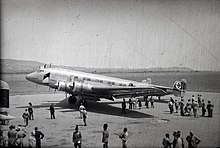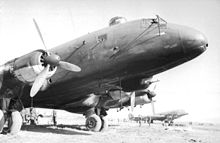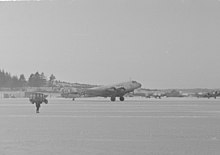Junkers Ju 90
| Ju 90 | |
|---|---|

| |
| Ju 90 V1 Der Grosse Dessauer with Daimler-Benz DB 600C motors, 1937 | |
| Role | Airliner, transport |
| National origin | Germany |
| Manufacturer | Junkers |
| First flight | 28 August 1937 |
| Introduction | 1938 |
| Primary users | Deutsche Luft Hansa Luftwaffe |
| Number built | 18 |
| Developed from | Junkers Ju 89 |
| Developed into | Junkers Ju 290 |
The Junkers Ju 90 was a four-engined airliner and transport aircraft designed and produced by the German aircraft manufacturer Junkers.
Derived from the abortive Ju 89 strategic bomber, it was developed to be used as a long-distance commercial aircraft for the German flag carrier Deutsche Luft Hansa. It drew heavily upon the Ju 89, sharing the same wing and tail unit while adopting an all-new fuselage that could seat up to 40 passengers. The design team was headed by Ernst Zindel,[1] and Professor Herbert Wagner.[2]
The first prototype performed its maiden flight on 28 August 1937 and entered service with Deutsche Luft Hansa shortly before the outbreak of the Second World War. During the conflict, the Luftwaffe pressed them into service as military transports.
Design and development
[edit]Background
[edit]The origins of the Junkers Ju 90 are directly connected with that of the Ju 89, a prototype strategic bomber. This aircraft, which had commenced developing during the mid-1930s, was a contender in the Ural bomber programme that was aimed at creating a long-range strategic bombing capacity for the Luftwaffe.[3] By the time that the Ju 89 programme had made it through to the flight testing phase, the development of four-engined bombers had become an increasing politically contentious matter, particularly following the untimely demise of General Wever (one of the programme's most powerful advocates) as well as rising tensions between Erhard Milch (another proponent) and commander-in-chief of the Luftwaffe, Hermann Göring. Recognising that strategic bombing was falling out of favour with the Reichsluftfahrtministerium (RLM) in favour of smaller and faster bombers, Junkers approached the RLM with their proposal to reuse the components intended for the third Ju 89 prototype to produce a transport aircraft for the German flag carrier Deutsche Luft Hansa instead.[4]
The RLM consented to Junkers' proposal, but only on the basis that an alternative engine to the Ju 89's Daimler-Benz DB 600A V-12 engine was used on any subsequent aircraft.[4] Accordingly, while the aircraft retained the wings and tail unit of the Ju 89, it also incorporated an all-new fuselage that was considerably wider and suitable for the carriage of passengers.[5][6][7] This new rectangular section fuselage was primarily constructed of duralumin along with some steel elements,[8] was relatively generous by the standards of the time, possessing an internal width of 2.83 m (9 ft 3+1⁄2 in).[citation needed]
In terms of its basic configuration, the Ju 90 was a four-engine all-metal low-wing aircraft fitted with twin end-plate vertical stabilizers.[5][9][10] The wings were built around five tubular girder spars and covered with a smooth stressed skin. The leading edge was quite markedly swept while the trailing edge was almost straight. The Junkers "double wing", a full-span movable flap/aileron combination, was also present.[11] The fins and rudders, the latter with prominent horn balances assemblies, were placed at the end of the tailplane; this latter carried the elevators separated by a gap, forming another double wing. The rudders and rear portion of the elevator of the prototypes were the only part of the aircraft to use the traditional Junkers corrugated skin; all other areas had a smooth duralumin covering that was flush-rivetted.[11]
The interior of the aircraft was could be configured into various cabin layouts; when arranged to maximise occupancy, the carriage of up to 40 passengers was possible.[11] Aft of the passenger compartments were Toilets, a cloakroom, a storage space for air mail; a baggage hold was located forward of the passenger compartment. The tailwheel undercarriage was fully retractable, the single-wheel main units were raised hydraulically into the inner engine nacelles.[4]
Into flight and civil usage
[edit]
On 28 August 1937, the first prototype, the Ju 90 V1, performed its maiden flight;[4] it was powered by four Daimler-Benz DB 600C liquid-cooled inverted V engines, each one capable of producing up to 820 kW (1,100 hp). These engines were more powerful than both those of its Ju 89 predecessor and subsequent production standard commercial Ju 90s. It was named Der Grosse Dessauer, as had been the earlier Junkers G 38. Deutsche Luft Hansa played a leading role in the long-distance portion of flight testing. On 6 February 1938, following eight months of flight tests, this first prototype was lost while performing over-speed tests.[5][4]

During May 1938, the second prototype (V2) was delivered to Luft Hansa for flight testing. Akin to all production standard commercial Ju 90s, this was powered by four BMW 132 radial engines delivering 620 kW (830 hp).[11] The move to lower power has been speculated to have been necessitated by the demands on Daimler Benz to produce engines for strategically important front-line aircraft.[7] This aircraft, named Preussen, was lost during a failed take off for tropical flight tests in November 1938 at Bathurst, Gambia.[12]
Despite these setbacks, Luft Hansa opted to order eight production standard Ju 90A-1 aircraft. They also flew the next two prototypes, starting with V3 Bayern which flew on the Berlin-Vienna route from July 1938.[4] This aircraft flew a total of 62,572 km ( mi) in 1938.[7] Only seven of the Ju 90A-1s were ever delivered to Luft Hansa, the final in April 1940, one going directly to the Luftwaffe.[10] Full scale passenger services were never introduced due to the outbreak of the Second World War.[12] The airline's Ju 90s were impressed into Luftwaffe service, although two were subsiquently returned to Luft Hansa.[12]
The Ju90 attracted some interest from prospective foreign operators. South African Airways (SAA) opted to order a pair of Ju 90A-1s, powered by four Pratt & Whitney Twin Wasp engines that could produce up to 670 kW (900 hp) each.[12] The delivery of these aircraft were scheduled to take place during the summer of 1939; however, neither aircraft were ever delivered to SAA.[12]
During July 1941, the fourth prototype V4 entered service with the Luftwaffe; it was fitted with 980 kW (1,320 hp) Jumo 211F/L engines.[citation needed] On the first four Ju 90As, five pairs of rectangular windows were on each side, each double pair lighting a divided-off section of the cabin containing eight seats in facing pairs on either side of a central aisle. On the Ju 90B, whose prototypes were the Ju 90 V5 through the Ju 90 V10 aircraft, adopted round fuselage portholes instead. The Ju 90 V11 became the definitive Ju 290 prototype, featuring smaller rectangular-shaped fuselage windows.[citation needed]
The Ju 90B series were visually distinctive due to their oval tail fins. The Ju 90 V6 was withdrawn from test flights, and rebuilt as the Ju 390 V1 prototype. The Ju 90 V9 was also withdrawn and rebuilt as the Ju 390V2, later redesignated in October 1944 as the Ju 390A-1. The rebuilding of Ju 90 V10 into the Ju 390 V3 bomber prototype was commenced, but was ultimately scrapped at the factory in June 1944. The Junkers firm was paid compensation for seven Ju 390s that were partially constructed when the corresponding orders were cancelled.[citation needed]
Militarisation
[edit]
In April 1939, the RLM asked Junkers for a further development of the Ju 90 for military transport purposes.[5][10] The Ju 90V5 and V6 were the prototypes of this military design. They got a new wing with a straight inner section leading edge, of greater span (19%) and area (11%). The landing gear was strengthened with twin main wheels and the fins were more rounded, lacking the characteristic horn balance nick of the earlier models. The windows were replaced by 10 small portholes a side. The Ju 90 V5 flew first on 5 December 1939. A special feature of both the V5 and V6 was a powered boarding ramp in the floor of the rear section of the fuselage for loading cars and larger cargo freight.[10][13] This Trapoklappe ramp, when lowered, was powerful enough to raise the fuselage to the horizontal flying position. Both aircraft were retroactively fitted with the much more powerful, unitized Kraftei-mount 1,200 kW (1,600 hp) BMW 801MA radials, with the first suffix letter "M" signifying the initial Motoranlage format of unitized powerplant installation design promulgated by the RLM. Ju 90s were also used as tugs for heavy gliders.[citation needed]

The two last prototypes – the V7 and V8 – fed directly into the Ju 290 development programme. The former had a fuselage extension of 1.98 m (6 ft 6 in) and the addition of dihedral to the tailplane to solve a yaw instability. A reconnaissance prototype aerodynamically similar to the V7, the V8 was armed, however, with two 20 mm MG 151/20 cannons and up to nine 13 mm (.51 in) MG 131 machine guns in two dorsal, one ventral, and one tail position.[citation needed]
The Ju 90 was used for the first time operationally during the invasion of Norway.[14][12] Operated as part of the Luftwaffe's transport force, they were deployed to the Eastern Front for a time to help supply the German 6th Army that was besieged at Stalingrad. They were subsequently transferred to the Mediterranean theatre, where they operated into late 1943.[15]
Ju 290 / 390 development
[edit]Several Ju 90s were converted into prototypes of the Ju 290, a larger aircraft intended for transport and reconnaissance duties. The more powerful engines and other modifications to the Ju 90 V5 and V7 were steps in this direction and the latter was converted into the Ju 290 V3. The Ju 90 V8 became the second prototype Ju 290 V2.[16] The incomplete Ju 90 V11 airframe was converted into the Ju 290 V1.[10][17] The Ju 90 V6 airframe was used in the construction of the Ju 390 V1.
Numbers and survivors
[edit]Ultimately, only 18 Ju 90s of all versions were completed. Just two aircraft survived the conflict, both being captured by the Allies and scrapped shortly thereafter.[5][6] The wreck of one Ju 90, which was shot down on 23 July 1943, south of Bastia, North Corsica, is easily accessible to scuba divers; by 2023, two-thirds of the aircraft was supposedly intact.[18]
Operators
[edit]Accidents and incidents
[edit]- 26 November 1938: a Deutsche Luft Hansa Ju 90V2, registration D-AIVI, named Preussen, crashed on takeoff at Bathurst (now Banjul), Gambia, while on a test flight due to double engine failure, killing 12 of the 15 people on board.
- 8 November 1940: a Deutsche Luft Hansa Ju 90A, registration D-AVMF, named Brandenburg, crashed in icing conditions at Schönteichen, Germany, killing all 29 on board.
- 9 August 1944: a Deutsche Luft Hansa Ju 90V3, registration D-AURE, named Bayern, was destroyed on the ground at Stuttgart Airport during an air raid; there was no one on board.
Specifications (Ju 90A-1)
[edit]
Data from Junkers Aircraft and Engines, 1913–1945,[10] German Aircraft of the Second World War[19]
General characteristics
- Crew: four
- Capacity: 38–40 passengers
- Length: 26.3 m (86 ft 3 in)
- Wingspan: 35.02 m (114 ft 11 in)
- Height: 7.5 m (24 ft 7 in)
- Wing area: 184 m2 (1,980 sq ft)
- Empty weight: 19,225 kg (42,384 lb)
- Gross weight: 33,680 kg (74,252 lb)
- Powerplant: 4 × BMW 132 H-1 nine-cylinder air-cooled radial piston engine, 610 kW (820 hp) each
- Propellers: 3-bladed constant-speed propellers
Performance
- Maximum speed: 350 km/h (220 mph, 190 kn) at 2,500 m (8,200 ft)
- Cruise speed: 320 km/h (200 mph, 170 kn) at 3,000 m (9,800 ft)
- Landing speed: 109 km/h (68 mph; 59 kn)
- Range: 1,247 km (775 mi, 673 nmi)
- Ferry range: 2,092 km (1,300 mi, 1,130 nmi)
- Service ceiling: 5,750 m (18,860 ft)
See also
[edit]Related development
Aircraft of comparable role, configuration, and era
Related lists
References
[edit]Citations
[edit]- ^ Zoeller, Horst. "Junkers – Who is Who? E". The Hugo Junkers Homepage. Archived from the original on 27 October 2009. Retrieved 22 June 2016.
{{cite web}}: CS1 maint: unfit URL (link) - ^ Zoeller, Horst. "Junkers Ju90 / Ju290 / Ju390". The Hugo Junkers Homepage. Archived from the original on 1 April 2020. Retrieved 22 June 2016.
- ^ Smith and Kay 1972, pp. 418-419.
- ^ a b c d e f Smith and Kay 1972, p. 419.
- ^ a b c d e Turner and Nowarra 1971, [page needed].
- ^ a b "Junkers Ju90". hugojunkers.bplaced.net. Retrieved 11 March 2023.
- ^ a b c "Airbus Group – Airbus Group". Archived from the original on 9 January 2009. Retrieved 28 August 2008.
- ^ Smith and Kay 1972, pp. 419-420.
- ^ Bridgeman 1942, [page needed].
- ^ a b c d e f Kay 2004, pp. 190–197.
- ^ a b c d Smith and Kay 1972, p. 420.
- ^ a b c d e f Smith and Kay 1972, p. 421.
- ^ Turner, P. St.J. and Nowarra, H. Ju 290 section
- ^ Junkers Ju90 Production List (Serials)
- ^ Smith and Kay 1972, pp. 421-422.
- ^ "Golden Years home".
- ^ Smith and Kay 1972, pp. 442-443.
- ^ "Epave du Junker 90 de l'IGESA - Bastia - EPAVE CORSE - Décembre 2016". 30 December 2016. Retrieved 11 March 2023 – via www.youtube.com.
- ^ Smith and Kay 1990, pp. 418–422.
Bibliography
[edit]- Bridgeman, L. (1942). Jane's All the World's Aircraft. London, UK: Sampson, Low, Marston & Co. Ltd.
- Kay, Anthony L. (2004). Junkers aircraft and engines, 1913–1945 (1st ed.). London: Putnam Aeronautical Books. ISBN 0851779859.
- Smith, John Richard; Kay, Anthony L.; Creek, Eddie J. (1972). German Aircraft of the Second World War. London, UK: Putnam and Company Ltd. ISBN 978-1-55750-010-6.
- Smith, John Richard; Kay, Anthony L. (1990). German aircraft of the Second World War (7th impression ed.). London, UK: Putnam and Company Ltd. ISBN 0851778364.
- Turner, P. St.J.; Nowarra, H. (1971). Junkers: an aircraft album no.3. New York, US: Arco Publishing Inc. ISBN 978-0-668-02506-5.
Further reading
[edit]- Zuerl, Walter (1941). Deutsche Flugzeug Konstrukteure. München, Germany: Curt Pechstein Verlag.
External links
[edit]- Four Miles a Minute Sky Sleeper Sleeps Forty, January 1938, Popular Mechanics article with rare photos of JU-90V1 version and interior photos
- WW2 in Color[permanent dead link] very good information on the JU-90 history
